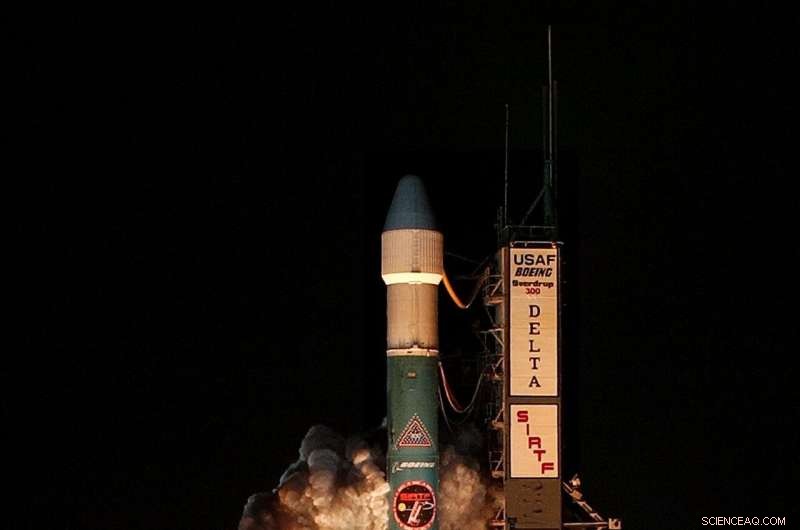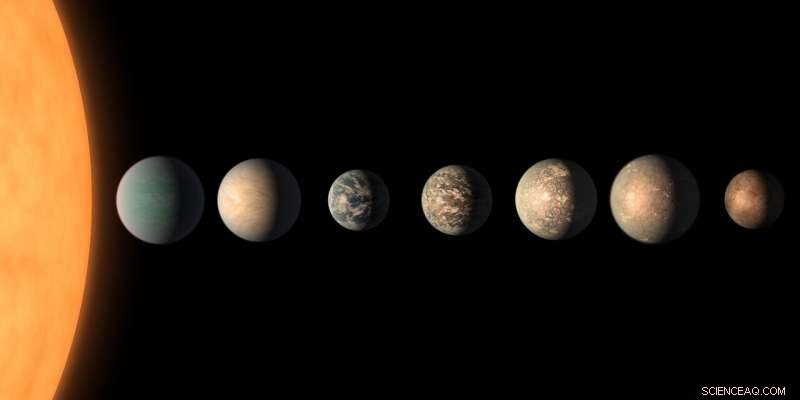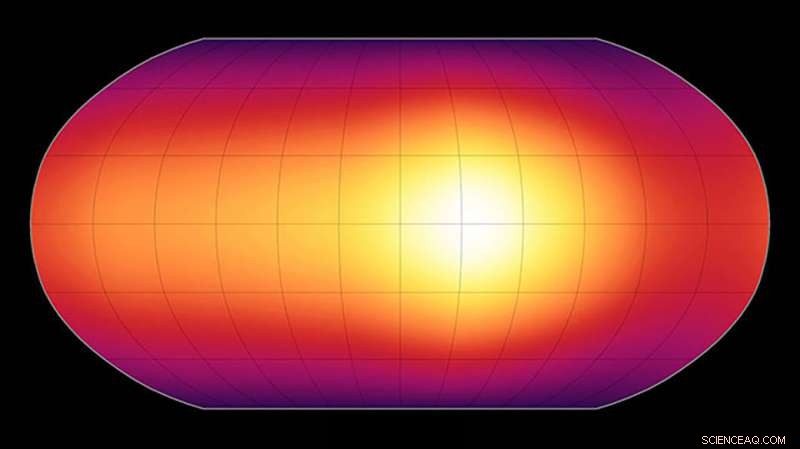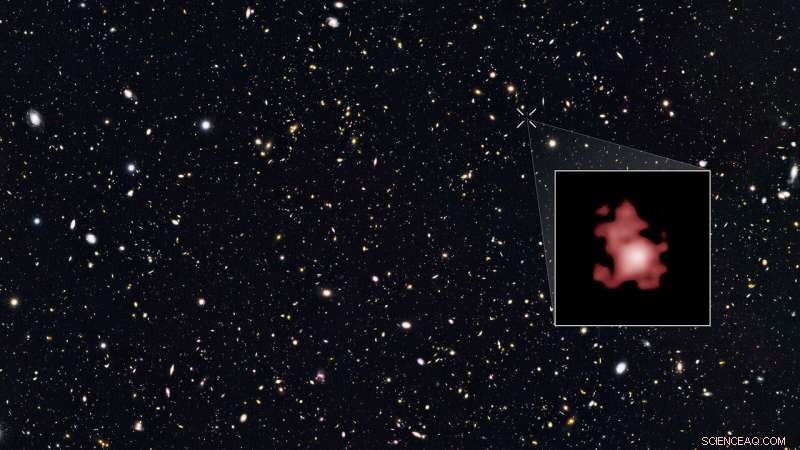
NASA:s Spitzer Space Telescope, då känd som Space Infrared Telescope Facility, uppskjutningar från Cape Canaveral Air Force Station i Florida på måndag, 25 augusti, 2003. Kredit:NASA
När ett fönster till universum stängs, en annan öppnas med en ännu bättre utsikt. Några av samma planeter, stjärnor och galaxer vi först såg genom det första fönstret kommer att dyka upp i ännu skarpare detalj i det som snart öppnas.
NASA:s Spitzer Space Telescope avslutar sitt uppdrag den 30 januari, 2020, efter mer än 16 extraordinära år av prospektering. Teleskopet har gjort många upptäckter bortom dess designers fantasi, såsom planeter utanför vårt solsystem, kallade exoplaneter, och galaxer som bildades nära universums början. Många av Spitzers genombrott kommer att studeras mer exakt med det kommande rymdteleskopet James Webb, som förväntas lanseras 2021.
"Vi har många nya frågor att ställa om universum på grund av Spitzer, sa Michael Werner, Spitzer-projektforskare baserad på NASA:s Jet Propulsion Laboratory i Pasadena, Kalifornien. "Det är mycket glädjande att veta att det kommer en sådan kraftfull uppsättning kapaciteter för att följa upp vad vi har kunnat börja med Spitzer."
Både Webb och Spitzer är specialiserade på infrarött ljus, som är osynlig för mänskliga ögon. Men med sin gigantiska guldbelagda berylliumspegel och nio nya teknologier, Webb är ungefär 1, 000 gånger mer kraftfull. Det kommande teleskopet kommer att kunna driva Spitzers vetenskapliga rön till nya gränser, från att identifiera kemikalier i exoplanetatmosfärer till att lokalisera några av de första galaxerna som bildades efter Big Bang.
Utöver dess upptäckter, Spitzer är också en vägvisare för Webb när det gäller hur man styr ett teleskop av det här slaget. För att mäta infrarött ljus med hög känslighet, ett teleskop måste vara väldigt kallt. Spitzer har visat ingenjörer hur ett infrarött observatorium beter sig i rymden och vilka temperaturer uppdragsplanerare bör förvänta sig att brottas med för Webb.
"Att ha ett stort teleskop i rymden är svårt. Men att ha ett stort teleskop som är kallt är mycket svårare, sa Amber Straughn, biträdande projektforskare för James Webb Space Telescope Science Communications. "Spitzer hjälpte oss att lära oss hur man bättre kan använda ett mycket kallt teleskop i rymden."
Med fler än 8, 700 vetenskapliga artiklar publicerade baserade på Spitzers upptäckter, teleskopet har varit en enorm tillgång för astronomer inom en mängd olika discipliner. Många av dessa lockande resultat är mogna för återbesök med ett kraftfullare teleskop, och Webb är redo att börja titta på dem tidigt i sitt uppdrag. Här är ett urval av Spitzers prestationer som Webb kommer att bygga vidare på.

Denna konstnärs koncept visar hur TRAPPIST-1 planetsystem kan se ut, baserat på tillgängliga data om planeternas diametrar, massor och avstånd från värdstjärnan. Spitzer Space Telescope bekräftade närvaron av två planeter av jordstorlek i systemet innan det upptäckte ytterligare fem. Kredit:NASA/JPL-Caltech
Exoplaneter
En av Spitzers mest fantastiska upptäckter var att det inte bara finns tre, men sju steniga planeter i jordstorlek som kretsar kring en liten, svag stjärna som kallas TRAPPIST-1. TRAPPIST-1 är ett av de bäst studerade planetsystemen förutom vårt eget, men det finns mycket mer att lära sig om det.
Den fjärde planeten från stjärnan, TRAPPIST-1e är särskilt intressant eftersom den har en täthet och ytgravitation som är mycket lik jordens och får tillräckligt med stjärnstrålning för att ha temperaturer som är tillräckligt vänliga för flytande vatten. Webb kommer att observera denna planet för att få en bättre känsla av om planeten har en atmosfär och, om så är fallet, vad dess kemi är.
Närvaron av molekyler som koldioxid, dominerande på Mars och Venus, skulle få konsekvenser för om en planet skulle kunna ha flytande vatten och andra beboeliga förhållanden. Webb kommer att kunna upptäcka atmosfäriskt vatten, för. Dessutom, Webb kommer att söka efter värme som kommer från TRAPPIST-1b, planeten närmast sin stjärna.
"Mångfalden av atmosfärer runt jordiska världar är förmodligen bortom vår vildaste fantasi, sa Nikole Lewis, biträdande professor i astronomi vid Cornell University i Ithaca, New York. "Att få information om luft på dessa planeter kommer att vara mycket användbart."
WASP-18b är en annan spännande planet som Spitzer undersökte och som Webb kommer att undersöka vidare i observationer tidigt i uppdraget. Denna gasjätte, med 10 gånger massan av Jupiter, ligger extremt nära sin stjärna, slutföra en omloppsbana en gång var 23:e timme. På grund av den höga temperaturen - hela 4, 800 grader Fahrenheit (2, 650 grader Celsius) - och stor storlek, it is known as a "hot Jupiter." Using data from Spitzer and Hubble, astronomers figured out in 2017 that this planet has a lot of carbon monoxide in its upper atmosphere and little water vapor. This planet is particularly interesting because it's so close to its star that it's in danger of being torn apart completely, and it may not survive another million years. Astronomers are interested in using Webb to look at the processes happening in this planet's atmosphere, which will provide insights into hot Jupiters in general.
Spitzer has also delivered unprecedented weather reports for exoplanets. Under 2007, it made the first-ever map of the surface of an exoplanet, the hot Jupiter HD 189733b, showing its temperature variations and cloud tops. På senare tid, in 2016, Spitzer highlighted the climate patterns of 55 Cancri e, a possibly lava-covered world more than twice the size of Earth. But maps from Spitzer have given scientists a lot to think about as they look to further investigations with Webb.

This is the first-ever map of the surface of an exoplanet, or a planet beyond our solar system. The map, which shows temperature variations across the cloudy tops of a gas giant called HD 189733b, is made from infrared data taken by NASA's Spitzer Space Telescope. Credit:NASA/JPL-Caltech/Harvard-Smithsonian CfA
Other Exotic Objects
Spitzer has also made strides in identifying and characterizing brown dwarfs. A brown dwarf is larger than a planet but less massive than a star, and while stars generate their own energy by fusing hydrogen, brown dwarfs do not. Spitzer has been able to look at the clouds in brown dwarf atmospheres and observe how they move and change shape with time. Webb will also examine brown dwarf cloud properties and delve deeper into the physics of these mysterious objects.
Infrared light has also been revolutionary for looking at disks of gas and dust orbiting stars, and both Spitzer and Webb are sensitive to the infrared glow of this material. Disks that Spitzer has studied contain the raw materials for making planets and may represent the state of our solar system before Earth and its neighbors formed. Spitzer has seen particles around young stars beginning to transform into the seeds of small planetary bodies, and that some disks have materials similar to those seen in comets in our solar system. Webb can look at the same disks and find out even more about the planetary formation process.
Oodles of Galaxies
As light travels from distant objects to Earth, its wavelength becomes longer because the universe is expanding and those objects are moving farther from us. Just like the sound of a siren seems to lower in pitch as an ambulance drives away, light from distant galaxies also lowers in frequency, a phenomenon called "redshift." That means stars that give off visible light in the early universe will appear in the infrared by the time their light reaches Earth. This makes infrared light an especially powerful tool for exploring the universe's ancient past.
Pinpointing hundreds of billions of galaxies is currently impossible, but Spitzer has made large galaxy catalogs that represent different slices of the universe, containing some of the most distant galaxies we know. The large survey areas of Spitzer and Hubble Space Telescope have allowed astronomers to efficiently look for objects that could be studied in further detail with Webb.
Till exempel, Spitzer, together with Hubble, took an image of a galaxy called GN-z11, which holds the record for most distant galaxy measured yet. It is a relic from when the universe was only 400 million years old, just 3% of its current age and less than 10% of its size today.

This is the first-ever map of the surface of an exoplanet, or a planet beyond our solar system. The map, which shows temperature variations across the cloudy tops of a gas giant called HD 189733b, is made from infrared data taken by NASA's Spitzer Space Telescope. Credit:NASA/JPL-Caltech/Harvard-Smithsonian CfA
"Spitzer surveyed thousands of galaxies, mapped the Milky Way and performed other groundbreaking feats by looking at large areas of the sky, " said Sean Carey, manager of the Spitzer Science Center at Caltech/IPAC in Pasadena, California. "Webb won't have this capability, but it will revisit some of the most interesting targets in the Spitzer surveys to reveal them in amazing clarity."
Vad mer, Webb's higher sensitivity will allow the telescope to look for galaxies dating back even earlier in the universe. And questions still abound about these distant galaxies:Are there a lot of stars forming in them or relatively few? Are they rich in gas or poor? Are there black holes at their centers, and how do those black holes interact with stars? Och, scientists have pondered a chicken-and-egg problem for decades about which came first:the black hole or the surrounding galaxy?
"We'll be able to see some of the earliest galaxies to form in the universe that we've never seen before, " said Straughn.
Closer to home, Spitzer also studied many examples of a mysterious kind of galaxy called a luminous infrared galaxy, or LIRG. Such galaxies are generating tens to hundreds of times more energy per second than a typical galaxy, and most of that energy takes the form of far-infrared light. Scientists have used Spitzer to study LIRGs and learn about star formation and the growth of black holes during periods of rapid evolution when galaxies collide and merge. Such collisions were even more common 6 billion to 10 billion years ago and influenced the evolution of the universe as we know it.
"Webb will take inspiration from Spitzer and examine a variety of nearby and distant LIRGs to learn more about the role of galactic mergers, bursts of star formation and the growth of supermassive black holes in galactic evolution over cosmic time, " said Lee Armus of Caltech, who will lead a LIRG observing program for Webb.
Into the Infrared Unknown
For more than 16 years, Spitzer mapped out many of the most pressing questions in infrared astronomy. Now it's up to Webb to revisit them with sharper vision, through the grandest window yet to the cosmos.